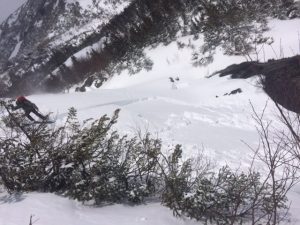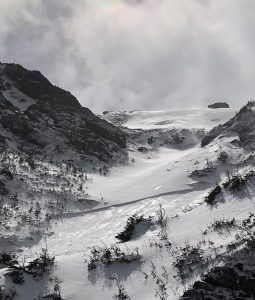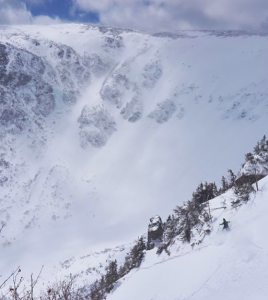On April 7, 2018, seven avalanches occured in Tuckerman Ravine. All were human triggered. This write-up discusses the weather and snowpack that lead up to these events, an objective summary of the events, and an analysis of factors that lead to at least five people being caught in one of the avalanches.
Weather
In the week leading up to April 7, 2018, our snowpack saw two rain events. The first was March 29 and 30 which delivered 0.75” of rain followed by 0.32” of rain on April 4. Both of these rain events were followed by hard freezes. On Friday, April 6, light snow showers began just after noon and continued through sunrise the following day. By the time snowfall stopped, the snowplot at Hermit Lake recorded 16cm (6.3”) of 9% snow while the summit recorded between 7 and 8” (this is an estimate based on hourly observations as the total snowfall was recorded as less due to excessive blowing snow) of snow. When snowfall began on Friday, wind at the summit was around 30mph from the south. Overnight, wind direction shifted to the west and speeds increased to 60-70mph. Weather on Saturday April 7 was clearing skies, winds diminishing to around 40mph from the west, and temperatures in the single digits on the summit and reaching into the 20sF at Hermit Lake. This weather pattern built a robust melt-freeze crust over which wind slab was built from new snow and wind April 6-7. This touchy wind slab was the avalanche problem involved in all known avalanches on April 7.
Summary of Events
During the morning of April 7, three avalanches were intentionally triggered by skiers. All three were ski cuts, two occurring in Lobster Claw (both SS-ASc-R1-D1.5-I) and one occurring on the rollover of the Little Headwall (SS-ASc-R1-D1-I). Slab depths were up to 14” and all occured on a layer of softer snow immediately above the melt-freeze crust. Of note in the Little Headwall was that the second skier through was able to trigger the “hangfire”, or slab remaining above the crown of the initial avalanche.
We have less definitive information on the Left Gully and Chute avalanches, which occurred shortly before and after the Hillman’s Highway avalanches, respectively. We believe that no one was caught or carried by either avalanche, both of which were triggered unintentionally. Left Gully, which was rated Moderate, produced an avalanche from a relatively thick though isolated pocket, while Chute, which was rated Considerable, produced a larger in area avalanche from a thinner slab. Both are estimated SS-ASu-R2-D1.
Unlike the other avalanches this day, the avalanches in Hillman’s Highway did involve a number of people being caught and carried. At approximately 2:00 pm, at least 40 people were climbing and skiing in Hillman’s. An individual climbing uphill from the looker’s right fork to the looker’s left fork triggered the initial avalanche as they entered the looker’s left fork. This person was not carried in the slide. The crown of this avalanche was approximately 300’ below the top of Hillman’s and ran ⅔ of the way down (SS-AFu-R2-D2-I). Of the many people in the avalanche path, at least 5 were caught and carried. USFS Snow Rangers responded to the incident and identified one injured skier who was ultimately transported to Pinkham Notch with a back injury that was not life threatening. Another individual who was also caught and carried sustained a minor injury to their hand.
The second avalanche was triggered around 2:30pm, within minutes of the initial Snow Ranger team arriving on scene. The trigger was unknown at the time, but consensus of bystanders is that this second avalanche was triggered by the same individual who triggered the first, having topped out on the ridge and beginning to ski the hang fire slab above the initial crown. This second avalanche was smaller (SS-ASu-R2-D1-I) and luckily did not capture any people or result in injuries.
Analysis
Many opportunities for learning are presented by this day which which fortunately did not involve more serious injuries. First, it’s an excellent reminder that avalanche conditions can develop during the spring months which bring crowds of backcountry skiers to Tuckerman Ravine. As with any time of year, these avalanches can widely vary in size and character. Avalanches can be of minimal concern on certain spring days, but April 7 was a day with avalanches as the primary concern for alpine travelers. On any such day, anyone venturing into avalanche terrain should bring a beacon, shovel, probe, and knowledge to use them effectively.
Carrying avalanche rescue gear is a cardinal rule for travelling in avalanche terrain. Another is travelling one at a time through areas exposed to avalanche danger. This requires recognizing avalanche terrain, which includes both terrain capable of producing an avalanche and terrain threatened by avalanches. A phrase often heard in the courtyard is, “It’s just Hillman’s”. All of Hillman’s Highway is avalanche terrain. On top of that, it’s easily the biggest gully in Tuckerman Ravine and is particularly confined. Exposing one person at a time to avalanche danger is crucial, particularly on a day like April 7. It’s likely that nobody would have been injured had this been the case.
Avalanche danger was Moderate in Hillman’s Highway on this day, which forecasts natural avalanches as unlikely and human triggered avalanches as possible. These possible human triggered avalanches can be either small and in many areas or large and in specific areas. With a number of similar avalanches in other Moderate rated areas, we consider April 7 as a small avalanches in many areas kind of day. It’s worth noting that a Moderate rated day for large avalanches in specific areas is sometimes referred to as “scary moderate”, in which you’re less likely to find signs of instability but potentially able to trigger a large avalanche. Further, remember that even small avalanches can ultimately be fatal.
The Chute was rated Considerable and produced a slightly larger in area avalanche from a thinner slab. The primary distinction between Moderate and Considerable is increased likelihood of both natural and human triggered avalanches with greater chance for larger avalanches. Other Considerable areas received little if any traffic, which we suspect is a reason that more did not produce avalanches.
All avalanche problems exhibit some degree of spatial variability. This means that the snowpack is not uniform across the terrain and avalanches can often only be triggered from specific locations. A number of people can travel on a slope, particularly one as large as Hillman’s, before someone finds this specific location and triggers an avalanche. Tracks on a slope do not mean it’s safe to ski or climb.
The Little Headwall was not rated on April 7 for lack of snow, but did have enough snow in one isolated pocket to produce an avalanche. Unrated terrain, which encompasses all of our terrain early and late in the season, can produce avalanches. The human triggered avalanche in Central Gully on Dec 1 of this season is another example. We do issue danger ratings for areas of most concern during the bulk of the season in Tuckerman and Huntington Ravines, but avalanche activity is not confined to areas forecast on a particular day.
Finally, we should touch on ski cutting. The avalanches in the Little Headwall and Lobster Claw were intentionally triggered in a controlled manner through ski cutting. This process of intentionally skiing a specific part of a slope likely to trigger an avalanche, with speed and from one safe zone to another, is an advanced practice and is only appropriate under certain conditions. A book could easily be written about the practice of ski cutting, but a simple explanation is that it is only wise when you possess a high degree of certainty about what the the ski cut will produce AND the consequences if you’re wrong. In particular, ski cutting is inappropriate when an avalanche may initiate above you. On April 7, we had the rare conditions for our terrain in which instability was limited to surface slabs and individuals were able to ski potential start zones for isolated and small pockets of wind slab. Certainty was high both in terms of anticipated result and consequences for being wrong, and avalanches above the individuals ski cutting were nearly impossible. Further, other people were not in the potential avalanche runout zones.
The human-triggered avalanches on April 7 did result in injury, but everyone on the mountain lived to ski and climb another day. Luck certainly contributed to this relatively positive outcome, as did the relatively small but widespread type of Considerable and Moderate avalanche danger that day. We who like to travel in avalanche terrain rarely get such valuable lessons without more serious outcomes. Great turns can be had with minimal risk on such days, but only by choosing terrain that matches your preparedness, knowledge, certainty, and skill level.



